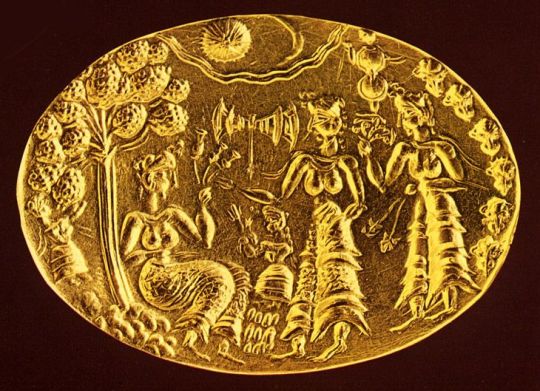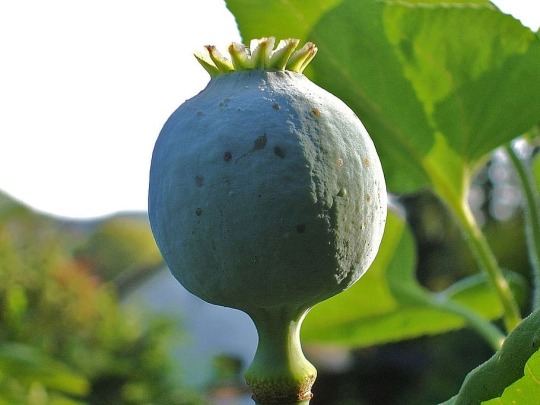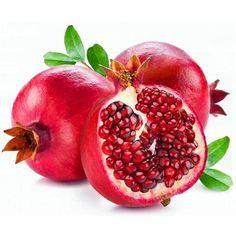#also bc persephone means bringer of death
Text
talking to myself about this prompt lol
like genuinely the entire hades/persephone thing as it relates to my version of emetwol (to the extent i've written any of it) is like. there's kind of a double meaning in it but both meanings are negative
on one level emet as an appealing but ultimately unhealthy and destructive suitor and also being Death The Guy is a reflection of pfeil's suicidal tendencies. instead of "marriage is like death, and separated families still have to grieve" as with the original it's more like, "if you are very sick, death can seem super inviting, but it is not. don't kill yourself!"
it's also a commentary about what i feel like persephone represents in a lot of conceptions of emetwol and the gender roles in the original myth and how those intersect, like, persephone as this sort of cage of idealized womanhood deprived of autonomy in favor of emet's control. because she's the perfect and more complete past self that emet controls wol's access to.
this doesn't actually happen in the end, but it's why pfeil's hypothetical lightwarden self is a clockwork machine with no will of its own that emet named persephone (bc of the folk etymology "bringer of death"). it is a bad thing to be under someone else's total control, especially as this intersects with misogyny. it's also the worst possible end for someone like pfeil, who sacrifices his sense of self and objectifies himself as a terrible and destructive coping mechanism around prior (Very Gendered) abuse. in his head, to live as a tool is to be Safe, because tools are always useful and can't feel pain, but the converse is, well, you can't feel anything else if you're an object. so persephone is that philosophy of his taken to its logical extreme, in that it's literally an object, which is why i only refer to it with it/its.
so in this context i really am struggling to think of how i can fill a prompt that implies persephone was not kidnapped and totally went with hades of her own volition and is not a signifier of the worst possible end with this particular permutation of emetwol. if persephone didn't actually represent disempowerment and death and self-destruction and restriction by patriarchy in pfeil's story that would be easy but she does and there isn't to me really a way around it? and the prompt is so unflinchingly positive about the union of hades and persephone. i can't cheese a secret totally other read here
4 notes
·
View notes
Text


oh shit i forgot to post these two here NDKDNK hades!ochako and persephone!toga
#hades!ochako#persephone!himiko#tgchk greek mythology au#??#togachako#togaraka#uratoga#tochako#togaocha#yes toga is wearing a toga#i thought about this once but ochako as persephone#i change the roles bc toga's fav fruit are pomegranates#also bc persephone means bringer of death#and ocha with a dark style is so cool and brings me sm serotonin#we need morr goth!ochako content now that i think about it#maybe...#*winks*
6K notes
·
View notes
Text
so i folded and binge-read lore olympus
im just gonna talk about it cause im bored and there’s stuff i wanna discuss about it. i’ve always been in love with the hades x persephone story (the first version i read was consensual so that’s the one that resonates with me the most)
im gonna start with the good stuff
- i love the animation! the colours are so fun and cool and i like how captivating they are, and the pink of persephone and blue of hades works well together
- i like that the time frame of olympus and the underworld is expedited compared to the modern world, that’s really neat
- the comedic timing is spot on, both the dialogue and animation can be so great and make me laugh to tears
- hades and persphone’s moments can be so tender and sweet, one scene between them that just sticks with me is when they are cooking together, or the first time she asked the names of his dogs and he lit up. they are so soft for each other and it makes my heart so so warm ;-; and i like their banter too
- i like hermes, and artemis, and eros, and basically everybody who’s become a friend in this series, they’re great (ares is an honourable mention bc he’s funny with amazing character design imo)
- the fact that therapy is a thing here??? pls they all need it omg
- the exploration of cycles in different extremes (the cycle of fertility goddesses being used for power, having shitty people around you in turn making you shitty to those you love, the fear of becoming one’s parents, etc)
- i like that none of the characters are “good” or “bad”. as it goes with deities, they are as morally grey as you can get especially in regard to mortals. (with the exception of apollo. i hate his character.)
- i appreciate the discussion of boundaries between hades and persephone, letting fluffy moments just be fluffy and sweet
- their relationship in general has very sweet moments and warms my heart a lot of times
- honourable mentions: baby hades being very worrisome for such a small boy, hades with his stars, hades with his crowns and earrings, hades with his little glasses, hades’ scars. hades. 💕
all in all, it’s a very fun read with many intriguing and cool themes that I love and i’m excited to see how it is concluded
now for critiques
- why did persephone have to be 19/20??? not 119, not 190, that young compared to everyone around her??? i mean even though on our (mortal) terms, she is legal and perfectly capable of making her own decisions. but the issue within most age gap relationships is not primarily the difference in years itself, but the difference in mindset and stages of life (a relationship between a 14 and 18 year old is vastly different from a relationship between a 30 and 34 year old). there doesnt seem to be a point to make her so young and then pair her with a being literally older than death itself, ya know? but that’s just me
- not necesarrily the characters, but more so the reactions to them. why is it that hades, modeled to be a capitalist business owner that keeps the dead souls as slaves and does things that are so cruel (i.e tear out some kids eye for a photograph or threaten an employee for asking for ID) is seen as a precious baby that can do no wrong?? now please understand that I love his character, I adore him!!! but he is no baby, and there is nothing stranger than seeing a morally grey character or straight up villain (who doesnt love a good villain every now and again amirite) be coddled and have excuses made for them while their female counterparts are villainized for the same or lesser offenses, which brings me to my next point
- minthe. she is no saint, and i dont like her all that much. she was petty and catty, and an awful and cruel partner towards hades. however, she is complex in that we see her internal monologue and can see that most of these things come from a place of insecurity and deep rooted issues with herself. not to excuse her behaviour because it is all very immature and lame, but i hope to see an arc from her that allows growth and letting go of being forced to see herself as nothing more than a trashy nymph. and learning to apologize properly
- also why was it funny when hecate smacked him across the face like three times but a crime when minthe hit him upside the head. my point is both were bad, but one gets forgotten and forgiven.
- man why is persephone drawn so mf tiny? i mean it’s cool to be short, but in some frames she’s legit at his waist which is a bit odd since you’re kind of already toeing the line of what is appropriate and what isn’t in their relationship (employer/employee relationship, extreme age difference, somewhat childish nature). i cant lie this feels nitpicky but it’s just so jarring everytime i see it combined with everything else, ya know??
- i dont know if the apollo incident was necessary. i feel the story would have been the same if had just been a pushy jerk trying to marry persephone because she is a fertility goddess for his own advantage. it was just an awful thing that provides very little substance to the plot and made me struggle to read it.
- im still a bit lost on where we are with what’s going on with persephone. when she goes into her “death bringer” state, why does it seem like she’s been possessed instead of it being embraced as who she is? i’d like to see her gain more control of these powers and maybe trained properly by someone so that the next time they are used, they are used with intent and purpose.
- lastly, why is persephone’s growth being stifled? we see her make mistakes, and fall short in certain areas, but i would also like to see her excercise agency and fix things for herself. we only got to see a glimpse of that, but i want more so that she can figure out for herself what and who exactly she is and what she wants without having to think about others and what they need from her. if she is to become the queen of the underworld we want her to be, she doesn’t need to be coddled all the time.
if there is anything more to be added to the conversation, pls feel free too!! i like conversation and this is an interesting topic!
#lore olympus#like literally no hate at all but i like being critical of the media i consume#lore olympus critical#lore olympus positive
66 notes
·
View notes
Photo

LADY MORPHINE
Deep into the Earth
I was (re)born,
skin covered in mud,
rising in a golden field
poppy crowned Goddess
ecstatic and sensual,
queen of intoxication
nurturing mother
sacrificial virgin
bleeding white nectar
bestower of peace
bringer of death.
PHARMACOLOGICAL BACKGROUND
The opium poppy was domesticated in Europe by 6000 BC and was widely used in the Mediterranean region for its medicinal properties. It was used in tinctures, concoctions, steam baths and pills to relief pain, fever, cough and treat wounds, insomnia and depression. A recipe of opium, mandrake and wine was used as an anaesthetic before amputations and other surgical procedures. According to Herakleides of Pontus (340 BC), euthanasia was widely extended in the Greek Islands, where people, especially women, lived until very old age. As they grew weak and before they became disabled, it was common for them to end their lives by taking a preparation of opium poppy. Poppies were known for bringing an easy and painless death.
Ancient Greek pharmacology distinguished two different preparations from poppies. “Opium” being extracted from the seed capsule of the poppy and taken internally, and “mekonion” being the result of boiling the poppy's leaves and fruits and most often used externally. Poppies and their derivates have accompanied us for a very long time.
Swiss-German alchemist Paracelsus reformulated a traditional opium tincture known as “laudanum” in the 16th-century. The use of laudanum was widely extended in Europe and it was used as a cure all in people of all ages, including babies. In 1804 Friedrich Serturner isolated morphine which became a popular and safer alternative to traditional opioids. In 1834 Pierre Robiquet isolated codeine while experimenting with different morphine extraction procedures. While laudanum still exists today, its prescription is rare and morphine and codeine have been the preferred opioids in the last two centuries. Diamorphine (heroin) is used to treat severe pain such as cancer and post-surgical pains. Heroin is commonly used as a recreational drug too and it's highly addictive. Heroin users become tolerant to the opioid very quickly and they need higher and higher doses to achieve the same euphoric effects. Under the name of diamorphine it's also prescribed as a maintenance treatment for long-term heroin addicts. Heroin is behind most deaths by drug overdose. Different opioids, but most often morphine, are used in palliative care to comfort patients throughout the dying process.
Outlined above we have a broad picture of how opium poppies have accompanied us through our history. This first draft focuses on opium uses and lore in Europe avoiding matters concerning heroin abuse, and its illegal production and distribution since I have no capacity to talk in depth about these matters. This is not an exhaustive paper and I expect to expand or change its contents in the future.
ORIGINS OF LADY MORPHINE
Opium poppy was more than a medicinal plant, it was a tool to achieve altered states of consciousness and visionary states, and a physical manifestation of the Great Goddess ancient Europeans worshiped.
We know poppy flowers originated in Europe, the oldest opium poppy seeds being found in Western European Neolithic burial sites of around 6000 BC. Opium poppy's are not the only psychotropic seeds found in such sites, cannabis seeds have been found too and most likely they had similar ritual uses, as well as being used for their medicinal properties. However, opium poppies' popularity meant they were imported to the rest of the continent and into Asia and Africa where we find depictions of poppies in ancient Egyptian and Assyrian art, and clay tablets describing some of their uses. In Crete, not far from Knossos, we found figurines of an “ecstasy goddess” wearing poppy capsules in her hair. The figurines' closed eyes and relaxed smile seem to show the euphoric feelings resulting from the use of opium. These figurines date from around 1300 BC.
It's from Minoan and later Hellenic sources that we can trace the symbolism and use of opium poppy in the European Neolithic and Bronze Ages and we can attempt to reconstruct its lore.
The Minoan civilization is considered the first advanced civilization in Europe. There's no evidence of a Minoan army and everything seems to point the Minoan Empire was ruled by an elite of priestesses. The Palace of Knossos, the biggest Minoan palace, doubled its functions as temple and political and administrative centre. Minoan palaces' paintings depicted scenes of Minoans' daily lives and their beliefs. Their goddesses were represented with poppies, serpents and birds taking this way the roles of initiator, Queen of the Underworld, of the Earth and the Sky, and prophecy, among others. Archaeological evidence points Minoan priestesses used opium and other herbal potions ritually to achieve trance states.
Around 1100 BC the Minoan civilization started to decline. A series of volcanic eruptions and foreign invasions changed this refined civilization forever. Under the Mycenaean Greek rule, the Minoan Great Goddess, her opium poppy and her cult passed to mainland Greece and were assimilated into the Hellenic religion, with a more conservative cult being preserved in the Eleusinian Mysteries.
In this process of religious assimilation and syncretization the Great Goddess was split and subsumed, denigrated and transformed. The poppy as a symbol of the goddess takes a discrete place in the new religion and its myths, in fact, it will be exchanged as fruit of the Queen of the Underworld by the more acceptable and innocent pomegranate. It's worth noting the physical resemblance between the pomegranate fruit and the poppy capsule, and their parallel symbology including, blood, fertility and death.
At the centre of the Eleusinian Mysteries which promised a blessed afterlife to the initiates, we have the goddesses Demeter and Persephone. These two goddesses, mother and daughter, were represented with baskets of poppies and ears of corn. The poppy's poetic name was “daughter of the field”, and its flowers splashing cereal fields with their red petals are a reminder of blood sacrifices nourishing the ground. Life and death intermingled.
The myth of the abduction of Persephone, at the heart of the Eleusinian Mysteries, has different layers of meaning. The legend says, Persephone was picking flowers in the Nysian fields with other nymphs when the ground opened and Hades seized her and brought her to the Underworld to make her his wife with Zeus' blessing. Demeter mourned the loss of her daughter and rendered the earth infertile bringing death and famine to the world. Hekate witnessed Persephone's abduction and helped Demeter to reach an agreement with Zeus and Hades. Persephone was then able to spend half year with her mother and and the other half in the Underworld with her husband, bound forever to Hades after eating a handful of pomegranate's seeds.
The most obvious interpretation of this myth is it's trying to explain the changing seasons. Demeter makes the earth fertile and fruitful during spring and summer when she reunites with her daughter. The rest of the year, the earth rests while Demeter mourns. When we focus our attention to the finer details of the legend, however, we start uncovering a whole new story. Persephone is not an innocent girl picking flowers for a nice bouquet. All the listed flowers have psychotropic properties, and she's picking them in the Nysian fields, the domain of Dyonisios, god of wine and ecstasy, and widely considered an alter ego of Hades. Therefore, we can understand this myth also as the tale of Persephone's initiation as a pharmakeus/witch/priestess. This interpretation is further reinforced by the fact Hekate, goddess of witchcraft and magic, stays in the Underworld with Persephone as her minister and companion.
Despite Hades being King of the Underworld, his lore is extremely limited and most often linked to that of Persephone. He never leaves his domains and shares his role with his wife, who rules as his queen and she travels between worlds. She's actively involved in other myths too. This seems to strongly confirm Persephone is, indeed, an older and more prominent deity squeezed into the Hellenic myth.
The Eleusinian and Orphic Mysteries focus on the deities mentioned above; Demeter, Persephone, Hekate and Hades/Dyonisios but it's worth to mention the central deity linking all the others is Persephone, “the bringer of death”, the poppy goddess, Queen of the Underworld.
Hekate, Demeter and Persephone form a triad usually interpreted as crone, mother and maiden respectively. However, another name for Hekate is Melinoe, “the dark one”, goddess of ghosts and nightmares. Under this name she's the daughter of Persephone and takes the place of the maiden in the triad. It's interesting to note how Melinoe/Hekate is the goddess of ghosts and nightmares/dreams, hallucinations and spirits, and daughter of Persephone, who's the bringer of death, the opium poppy, the seed, and daughter of Demeter, the fertile field. A full goddess' recycling.
Melinoe is not the only child of Persephone though. She's mother to the serpent Zagreus, the first child of Zeus who was supposed to take the throne from his father but was dismembered and eaten by the Titans. His heart the only piece left whole and rescued by Athena who gave it to Zeus. He then prepared an elixir with Zagreus heart and gave it to Semele to drink, who got pregnant and gave birth to the god Dyonisios, “born twice”, the reincarnation of Zagreus, god of wine and ecstasy and the prototypical shaman or mystic.
Dyonisios/Zagreus married Ariadne (“the most holy”), Minoan Lady of the Labyrinth completing this way the cycle and taking his place once again, as son-consort of the Great Goddess. Ariadne, who was also identified as another face of Persephone, keeper of the labyrinth of initiation and goddess of the snake and ecstasy. The labyrinth is an universal symbol of birth-death-rebirth and transformation.
We have seen now, the symbols and elements of the Minoan Great Goddess and her cult recycled in Greek mythology. The poppy that grows in Demeter's fields and in Hekate's garden in Kolchis, and the serpent in Zagreus. Life and death, and rebirth. The changing of seasons, the cycles of the Earth, the ages of the Moon, the power of blood, the visionary states, the seeds of the poppy and the pomegranate, and the labyrinth. A circle within a circle, within a circle...
The initiate to the Goddess mysteries would go on a vision quest, entering the labyrinth with the help of a drink of opium wine. A vision of the fertile Elisian Fields where each soul is a seed awaiting.





#mythology#persephone#demeter#hekate#ariadne#zagreus#dyonisos#minoan#goddess#opium#morphine#ancient pharmacology#my thesis#paganism#shamanism
49 notes
·
View notes